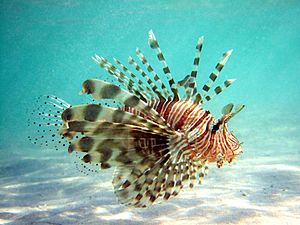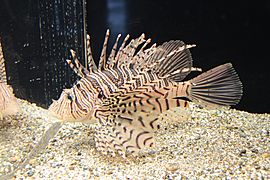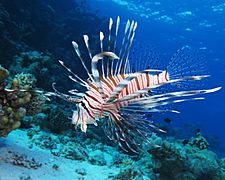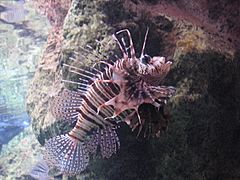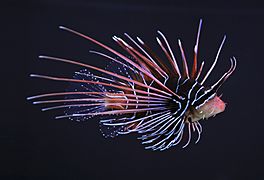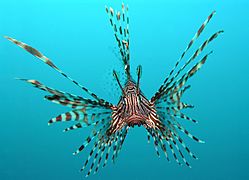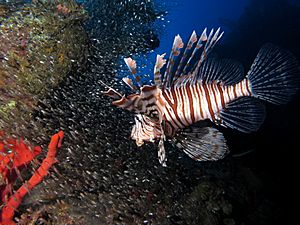Pterois facts for kids
Quick facts for kids Pterois |
|
|---|---|
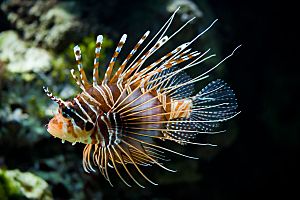 |
|
| Pterois antennata | |
| Scientific classification | |
| Kingdom: | |
| Phylum: | |
| Class: | |
| Order: | |
| Family: | |
| Subfamily: |
Pteroinae
|
| Genus: |
Pterois
Oken, 1817
|
Pterois is a group of venomous ocean fish often called lionfish. They come from the Indo-Pacific region. People also call them zebrafish, firefish, turkeyfish, or butterfly-cod. Lionfish are easy to spot because of their bright colors like red, white, cream, or black stripes. They also have fancy fins and spiky, venomous (poisonous) rays.
Some of the most studied types of lionfish are Pterois radiata, Pterois volitans, and Pterois miles. Many people like to keep Pterois species in their aquariums. However, P. volitans and P. miles have become a big problem in the west Atlantic, Caribbean Sea, and Mediterranean Sea because they are invasive species. This means they are not native to these areas and can harm the local environment.
Contents
What Lionfish Look Like
Lionfish found in the Atlantic Ocean can grow from about 5 to 45 centimeters (2 to 18 inches) long. They can weigh from 0.025 to 1.3 kilograms (0.05 to 2.8 pounds). They are famous for their beautiful looks, their venomous spines, and their unique tentacles.
Young lionfish have a special tentacle above their eyes. This tentacle looks different depending on the type of lionfish. Scientists think this tentacle helps them attract new prey. It might also play a role in how they choose their mates.
Types of Lionfish
There are currently 12 known types of lionfish in the Pterois group. Here are some of them:
- Pterois andover – Andover lionfish
- Pterois antennata – Spot-fin lionfish
- Pterois brevipectoralis
- Pterois cincta – Red Sea lionfish
- Pterois lunulata – Luna lionfish
- Pterois miles – Devil firefish
- Pterois mombasae – African lionfish
- Pterois paucispinula
- Pterois radiata – Clear-fin lionfish
- Pterois russelii – Plaintail turkeyfish
- Pterois sphex – Hawaiian turkeyfish
- Pterois volitans – Red lionfish
Life Cycle and Behavior
Lionfish can live for 5 to 15 years. They have interesting ways of finding a partner and mating. Female lionfish often release two groups of eggs covered in mucus. Each group can have as many as 15,000 eggs! Scientists have been studying how lionfish reproduce much more in recent years.
All types of lionfish use warning coloration. This means they have bright, contrasting stripes and large, spiky fins. These colors and spines tell other animals that lionfish can defend themselves.
What Lionfish Eat
Lionfish mostly eat small fish, invertebrates (like crabs or shrimp), and mollusks (like snails). One study looked at over 1,400 lionfish stomachs. Some of them had up to six different types of prey inside!
Lionfish seem to eat the most in the morning, from 7:00 to 11:00 a.m. They eat less as the afternoon goes on. They are very good hunters. Lionfish use special muscles around their swim bladder to move precisely in the water. This helps them change their balance to attack prey better. Then, they spread their big pectoral fins and swallow their prey in one quick gulp.
They also blow jets of water at their prey. This seems to confuse the prey and turn them around to face the lionfish. This makes it easier for the lionfish to catch them head-first.
Who Eats Lionfish?
Adult lionfish have very few natural predators. This is probably because their venomous spines are so effective. Sometimes, bigger lionfish will even eat smaller ones.
Some animals that have been seen eating lionfish include moray eels, bluespotted cornetfish, and large groupers. These include the tiger grouper and Nassau grouper. However, we don't know how often these predators actually eat lionfish. Sharks are also thought to be able to eat lionfish without getting hurt by their spines. In 2011, officials at the Roatan Marine Park in Honduras tried to teach sharks to eat lionfish. This was an effort to control the growing number of invasive lionfish in the Caribbean. The Bobbit worm, which hides and ambushes its prey, has also been filmed eating lionfish in Indonesia.
We don't know much about what eats baby lionfish or their larvae. These unknown predators might be what keeps lionfish numbers in check in their native homes.
Lionfish rarely have parasites. When they do, they are usually isopods or leeches.
Lionfish and People
Lionfish are known for their venomous fin rays. This is unusual for fish on the East Coast coral reefs. Their strong venom makes them great hunters, but also dangerous for fishermen and divers.
If a human is stung by a lionfish, the venom can cause many problems. These include extreme pain, nausea, vomiting, fever, trouble breathing, convulsions, dizziness, redness where stung, headache, numbness, a pins-and-needles feeling, heartburn, diarrhea, and sweating. In rare cases, stings can cause temporary paralysis, heart failure, or even death. Deaths are more common in very young children, older people, those with weak immune systems, or people who are allergic to the venom.
The venom is rarely deadly for healthy adults. However, some types of lionfish have enough venom to cause extreme discomfort for several days. If someone is allergic to lionfish venom, they could have a very serious reaction called anaphylaxis. This is a life-threatening condition that needs immediate medical help. Signs of a severe allergic reaction include chest pain, serious breathing problems, a drop in blood pressure, swelling of the tongue, sweating, a runny nose, or slurred speech. These reactions can be deadly if not treated right away.
Lionfish can be eaten if they are prepared properly.
Where Lionfish Live
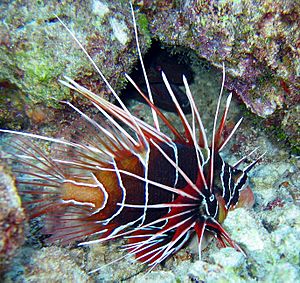
Lionfish are predators that originally come from the Indo-Pacific region. They aggressively hunt small fish and invertebrates. You can find them around the edges of reefs and coral, in lagoons, and on rocky areas. They usually live in waters up to 50 meters (164 feet) deep. However, they have sometimes been seen as deep as 300 meters (984 feet).
They prefer cloudy areas near the shore and in harbors. Lionfish are generally aggressive and protective of their territory towards other reef fish. Many universities in the Indo-Pacific have reported lionfish being aggressive towards divers and researchers.
P. volitans and P. miles live in warm areas from southern Japan and southern Korea to the east coast of Australia, Indonesia, Micronesia, French Polynesia, and the South Pacific Ocean. P. miles is also found in the Indian Ocean, from Sumatra to Sri Lanka and the Red Sea.
Images for kids
-
P. volitans is the most common type of invasive lionfish in the Atlantic and Caribbean.
See also
 In Spanish: Pterois para niños
In Spanish: Pterois para niños


